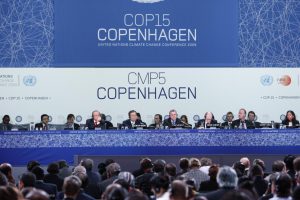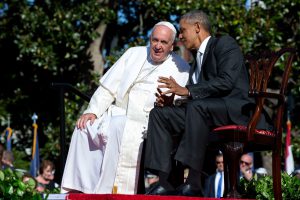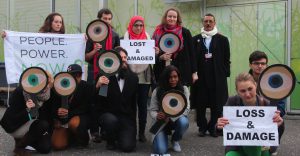Negotiators have got just under two weeks to agree a deal that sets the world on a path to avoid the worst effects of global warming. In contrast to the last major climate summit in Copenhagen in 2009, which ended in acrimony, the question isn’t so much whether an agreement will be signed, but if it will be ambitious enough. After a year of tireless diplomacy and the trauma of recent jihadist attacks in Paris, there is too much at stake for the French hosts for no deal to emerge.
But huge uncertainty remains over whether the talks will decide on clear decisive steps that will help the world limit a rise in average global temperatures to 2C or below. This outcome can only be reached through a decisive shift to low carbon energy, and away from fossil fuels and other sources of greenhouse gases (GHGs). Concentrations of greenhouse emissions this year broke through the 400 through parts per million (ppm) level, the highest for a million years, and the world is now dangerously close to a tipping point beyond which climate change will wreak increasing havoc with the world’s ecology and weather, putting many in the planet at risk from flooding, droughts and extreme temperatures.
Here are the main issues that are at stake in Paris:
Emission cuts from 2020 and a long-term goal
Over 180 national climate plans submitted to the UN in the run-up to Paris, known as Intended Nationally Determined Contributions (INDCs) if enacted fully, would put the world on a path to a rise in average temperatures to 2.7C, according to estimates.
These INDCs, will need to made much more ambitious, and very quickly, if the world is to cap temperature rises at 2C, and even that level of global warming would spark a much greater incidence of extreme weather events. The most vulnerable countries, such as the small island states, say a temperature rise above 1.5C will wipe them off the map.
Most of the big emitters, such as China, the EU, and the US, have set many of their carbon-cutting policies in motion already. These include curbs on coal-fired power plants and the fixing of targets to increase the share of renewables and electric vehicles that would be combined with efficiency measures and smarter power grids.
These policies are intended to deliver on overall targets included in INDCs. For example the US has committed to cut its GHG emissions 26
But for the world to remain within its carbon budget – the amount of fossil fuels that the world can ‘safely’ burn and remain under a 2C warming threshold – the world’s biggest economies and fast-growing developing countries will need to deepen these targets. This will require a decisive shift away from coal and oil, so that the emissions curve can be bent sharply lower.
This will involve countries such as China and the US – the world’s two largest emitters – retiring decades-old energy infrastructure and ensuring that their low-carbon replacements can deal with high levels of energy demand spurred by population rises and economic growth. There’s also the crucial question of whether India, the world’s third-largest emitter, can be persuaded to forego the massive use of coal that enabled western countries to industrialise and achieve their economic wealth.
So far, India has shown few signs of relinquishing what it sees as its right to use much of the world’s remaining carbon budget. Enshrining a ‘long-term goal’ to slash emissions from current levels by 2050, and an undertaking to completely decarbonise by 2100, even if there is no legal compulsion to do so, would be a major achievement for a Paris deal. But getting agreement from big developing countries will likely involve major breakthroughs on finance and technology transfer.
Ratchet and review
If the world is to achieve deep decarbonisation by mid-century, regular reviews every five years or emissions cuts from 2020 will be essential, say countries most at risk of climate change, and those developed countries such as the US and EU member states who want to see all major emitters pull their weight.
To send out strong messages to the energy sector, industry and urban planners, supporters of regular reviews want countries to come back to the table with detailed updates on how shifts to low carbon energy have progressed, and how carbon cuts are being deepened. Regular reviews – and a long-term goal – would also send a strong signal to the private sector that a strong shift away from fossil fuels is a reality.
But although China has dropped its previous opposition to five year reviews, other large emitters, such as India, remain hostile. For least developed countries, ratchet and review is a positive as it could also apply to commitments on finance from richer countries. By the end of next week in Paris, much greater clarity will be required on how a review of countries’ commitments would work for deal to have widespread legitimacy. But it is likely to be non-punitive. As US lead negotiator Todd Stern has put it, such a mechanism is likely to be along the lines of a strong facilitative review that looks at what a country has done and says: “That looks good, you’re on track,” or: “That doesn’t look so good. How can you be helped to do better?”
A binding treaty?
The question of whether a climate agreement should be ‘legally binding’ has long been a major point of contention at UN climate talks. The Copenhagen summit failed mainly because very few large emitters were prepared to accept binding targets amid clear divisions on who should shoulder the burden of emissions cuts.
The US, and other large emitters such as India, have made clear their opposition to a Kyoto-style component enforcing carbon cuts. Jennifer Morgan, global director at the World Resources Institute, said the Paris talks may instead attempt to agree a clause that countries shall report and maintain their commitments or implement policies to achieve targets proposed through INDCs.
Monitoring, reporting and verification
How can countries be sure that others are delivering on their commitments? The EU and US have long insisted that robust systems of monitoring, reporting and verification (MRV) of emissions and policies are implemented in an agreement. China has recently softened its previously trenchant opposition, which was based on concerns about impingement of national sovereignty.
However in the views of some observers, fears about encroachment by western countries are overblown. Countries willingly participate in regular policy surveillance conducted through the International Monetary Fund (IMF) Article 4 consultations and the World Trade Organisation (WTO) Trade Policy Review Mechanism, points out Havard University’s Joseph Aldy. Expert review by the IMF and WTO – through the collection and analysis of data and public policies – feeds into a peer-review process that is substantially more rigorous, informative and credible than the status quo climate policy MRV, he adds.
For many developing countries, a robust MRV system could be a benefit because it would likely also apply to the delivery and type of climate finance promised by rich countries, and provide greater transparency on the sources of public funding.
Finance
Finance is a strand of the talks that is most likely to prompt a crisis in Paris and block progress towards a meaningful agreement, a prospect acknowledged by French President Francois Hollande at the opening day of the summit.
Developing countries say that commitments by rich nations towards the US$100 billion a year in climate finance from 2020 made in Copenhagen are opaque and to some extent have been diverted from existing overseas aid budgets. Rich nations say over US$60 billion has been raised and that over the next four years the remainder of the US$100 billion is likely to be found through the increasing involvement of the private sector.
Poorer countries will also want to see greater clarity on how international finance can be scaled up from billions to the trillions of finance that will be needed for low carbon infrastructure and adaptation to climate change. But for financial institutions to put much more money on the table, government support will be crucial so that the private sector will have increased incentives to free up cash, points out Sean Kidney of the Green Bonds initiative.
While a Paris agreement is thought unlikely to include a clause on carbon trading and carbon taxes, at a national level various INDCs, including China’s, propose the use of price signals (such as the use of carbon trading) to shift investment away from fossil fuels. Meanwhile, the prospect of an increasingly carbon-constrained world has prompted an increasing number of financial institutions, such as France’s Axa and Germany’s Allianz, to ditch investments in coal amid fears of ‘carbon bubble’ and being saddled with ‘stranded assets’.
While many investors have so far been less willing to abandon oil, signs of oversupply and the prospects of a roll-out of electric vehicles may also prompt finance houses to curb exposure to the fuel that is the second-biggest contributor to climate change after coal.
In addition, some of the world’s richest companies, many of which are in the tech sector, are ramping up investments in wind, solar, and electric vehicles, while Microsoft founder and philanthropist Bill Gates on Monday pledged US$1 billion to a proposed fund that aims to speed up development of low carbon electricity and new sources of energy.
Loss and damage
For decades, developing countries have been demanding ‘loss and damage’ funding from rich nations that would help them recover from natural disasters that were triggered or worsened by climate change. The calls have grown increasingly shrill in recent years as the impacts of climate change have become increasingly apparent, but developed countries are at pains to avoid a system that would expose them to huge compensation claims. Countries most at risk from climate change-related events that they can’t adapt to – such as rising seas – will insist that this clause is included in the core text of a Paris agreement. Rich countries will likely try to block them.







